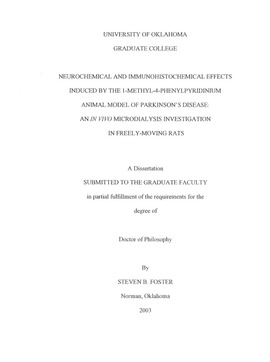| dc.contributor.advisor | Dryhurst, Glenn, | en_US |
| dc.contributor.author | Foster, Steven Bradley. | en_US |
| dc.date.accessioned | 2013-08-16T12:19:15Z | |
| dc.date.available | 2013-08-16T12:19:15Z | |
| dc.date.issued | 2003 | en_US |
| dc.identifier.uri | https://hdl.handle.net/11244/673 | |
| dc.description.abstract | Parkinson's disease (PD) is a neurodegenerative disorder which afflicts more than 1 million Americans with an estimated 50,000 new diagnoses each year. 1-methyl-4-phenyl-1,2,3,6-tetrahydropyridine (MPTP) causes parkinsonian symptoms in humans, and in animals most faithfully mimics the chemical, pathological and immunohistological features of idiopathic PD. In the nigrostriatal pathway, MPTP evokes selective degeneration of dopamine (DA) neurons in the substantia nigra pars compacta (SNpc). Dopaminergic neurons project their axons into the striatum where MPTP induces a loss of DA and degeneration of dopaminergic terminals. Perfusion of neurotoxic concentrations of 1-methyl-4-phenylpyridinium (MPP+; the active metabolite of MPTP) into the rat striatum reversibly inhibits mitochondrial complex I and, hence, causes a transient ATP energy impairment leading to activation of N-methyl-D-aspartate (NMDA) receptors, a massive release of DA and a rise in the extracellular concentrations of glutathione (GSH) and cysteine (Cys). Elevated extracellular levels of Cys along with glutamate (Glu) and glycine (Gly) evoked by MPTP/MPP + may primarily originate from degradation of GSH by gamma-glutamyl transpeptidase (gamma-GT) and dipeptidases. | en_US |
| dc.description.abstract | In the present microdialysis study, neurotoxic concentrations of MPP + were perfused into rat striatum and dialysate was analyzed. Extracellular markers of reactive oxygen and nitrogen species were not detected in the presence or absence of coperfused acivicin (an inhibitor of gamma-GT). Inhibition of gamma-GT was not neuroprotective to DA neurons and had no significant effect on the MPP+-mediated rise of extracellular concentrations of Glu, Cys and Gly. Immunohistochemical studies of the striatum showed that with increasing concentrations of MPP+ there was a corresponding increase in DA terminal damage, loss of astrocytes, formation of reactive microglia and cell death. | en_US |
| dc.description.abstract | Perfusion of MPP+ evoked the neurotransmitter-like release of L-3,4-dihydroxy-phenylalanine (L-DOPA) which was also detected in dialysate from experiments where rats received neurotoxic doses of methamphetamine or 3,4-methylenedioxymethamphetamine. The release of L-DOPA was found to be the result of (in vivo not in vitro) MPP +-induced inhibition of L-DOPA decarboxylase (DDC). The results from the present study suggest that DDC inhibition with subsequent L-DOPA release may play a role in MPP+-induced neurotoxicity and, because of the similarities of MPTP/MPP+-induced neurotoxicity and PD, may be an early event in PD. | en_US |
| dc.format.extent | xxxiii, 278 leaves : | en_US |
| dc.subject | Chemistry, Analytical. | en_US |
| dc.subject | Biology, Neuroscience. | en_US |
| dc.subject | Neurotoxicology. | en_US |
| dc.subject | Dopamine. | en_US |
| dc.subject | Parkinson's disease. | en_US |
| dc.subject | Methylphenyltetrahydropyridine. | en_US |
| dc.title | Neurochemical and immunohistochemical effects induced by the 1-methyl-4-phenylpyridinium animal model of Parkinson's disease: An in vivo microdialysis investigation in freely moving rats. | en_US |
| dc.type | Thesis | en_US |
| dc.thesis.degree | Ph.D. | en_US |
| dc.thesis.degreeDiscipline | Department of Chemistry and Biochemistry | en_US |
| dc.note | Adviser: Glenn Dryhurst. | en_US |
| dc.note | Source: Dissertation Abstracts International, Volume: 64-10, Section: B, page: 4904. | en_US |
| ou.identifier | (UMI)AAI3109068 | en_US |
| ou.group | College of Arts and Sciences::Department of Chemistry and Biochemistry | |
